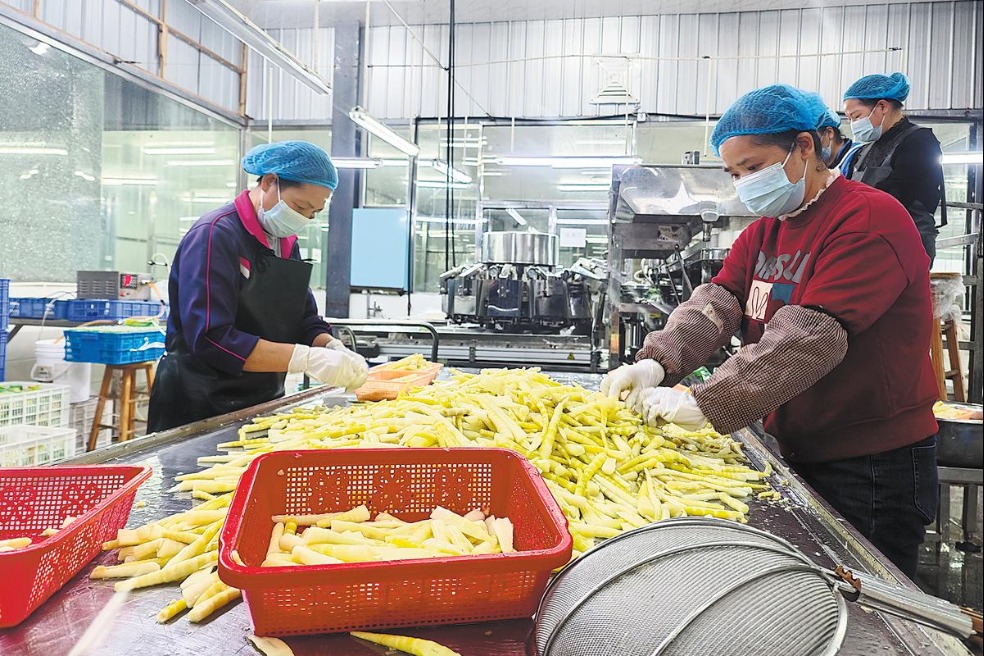DEBATE FUELED AS BIDEN TAPS KEY PETROLEUM STOCKPILE
Rising gasoline prices highlight US political divide

In response to rising gasoline prices and amid political rumblings, United States President Joe Biden has tapped the nation's Strategic Petroleum Reserve to increase the available oil supply while promoting a transition from fossil fuels.
The emergency reserve is stored in dozens of underground salt caverns in Texas and Louisiana. It was established in 1975 by President Gerald Ford after the 1973-74 oil embargo by Arab members of the Organization of Petroleum Exporting Countries, or OPEC.
The embargo was aimed at nations that supported Israel during the Yom Kippur War in October 1973. The countries initially targeted were the US, the United Kingdom, Canada, Japan and the Netherlands. By the end of the embargo in March 1974, the price of oil had risen by nearly 300 percent.
In those days, and in the second oil shock of 1979 amid the Iranian revolution, drivers in the US had to wait in long lines for rationed gasoline-sometimes based on their vehicle license plate or days of the week.
The Strategic Petroleum Reserve, or SPR, has been used in emergencies such as the buildup to the Gulf War in 1991 and the aftermath of Hurricane Katrina in 2005, which was centered on the New Orleans area. Much of the oil infrastructure along the Gulf of Mexico was damaged in the devastating storm.
The SPR accommodates more than 700 million barrels to be used "to counter a disruption in commercial oil supplies which could threaten the US economy", according to the Department of Energy, or DoE, which manages the stockpile. The oil can be sold to other countries and used to pump more supply into the market.
The SPR inventory as of April 1 was 564.6 million barrels, comprising 249.8 million barrels of sweet crude and 314.8 million barrels of sour crude, according to the DoE.
As of August 2020, the four SPR storage locations were connected by government pipelines and commercially owned pipelines and terminals to 28 refineries on the Gulf of Mexico coast and a total of six refineries in Michigan, Ohio and Kentucky. The SPR is also connected to three marine terminals-two in Texas and one in Louisiana.
On March 31, Biden announced the largest-ever release from the reserve, with the aim of easing prices for consumers at the gasoline pumps.
A White House statement said: "The scale of this release is unprecedented: the world has never had a release of oil reserves at this 1 million (barrels) per day rate for this length of time. This record release will provide a historic amount of supply to serve as a bridge until the end of the year when domestic production ramps up."
Once the president calls for a release, it can take at least 13 days for the oil to go out for delivery, according to the DoE.
The first 90 million barrels will be released from May to July through two notices of sale totaling 70 million barrels, with 20 million barrels already scheduled to be released next month, the department said. The remaining 90 million barrels will be released from August to October.
Last month, the Biden administration announced a release of oil from the reserve, in conjunction with other nations. The president also released about 50 million barrels in November.
Mike Sommers, CEO of the American Petroleum Institute, or API, said in a statement on March 31, "The SPR was put in place to reduce the impact of significant supply chain disruptions, and while today's release may provide some short-term relief, it is far from a long-term solution to the economic pain Americans are feeling at the pump."
According to its website, the API "represents all segments of America's natural gas and oil industry".
Sommers said: "The best thing the White House can do right now is to remove barriers to investment in American energy production and infrastructure. Unfortunately, today (March 31) we heard more mixed signals about developing affordable, reliable and secure American natural gas and oil."
Experts testify
The issue of high gasoline prices, like many in US society, reflects the nation's political divide. On one side are proponents of cheap fuel and gasoline-powered vehicles. On the other, are those looking to fight climate change while pushing for hybrid and electric vehicles to reduce carbon emissions.
The Sierra Club, a prominent environmental advocacy group founded in 1892, said in a statement on March 31, "The current spike in gas prices and supply chain shortages are reminders that the only way to truly achieve energy security is to rapidly transition away from fossil fuels and invest at the size and scale necessary to power the country through clean, renewable energy.
"As President Biden is taking steps to ease everyday Americans' energy burden in the short term, Congress must move swiftly to meet the moment."
On April 6, top executives from BP America, Chevron, Devon Energy, ExxonMobil, Pioneer Natural Resources and Shell USA testified about surging gasoline prices to the House Energy and Commerce Committee via video link.
Diana DeGette, a Colorado Democrat and chair of the Energy and Commerce subcommittee on oversight and investigations, said, "These prices are constraining our constituents' budgets and patience."
Michael Wirth, chairman and CEO of Chevron, replied: "I want to be absolutely clear. We do not control the market price of crude oil or natural gas, nor of refined products like gasoline and diesel fuel, and we have no tolerance for price-gouging."
Committee chairman Frank Pallone Jr., a New Jersey Democrat, said: "At a time of record profits, Big Oil is refusing to increase production to provide the American people some much-needed relief at the gas pump. Instead, they're buying back their stock at an estimated cost of about $40 billion this year."
Cathy McMorris Rodgers, a Washington state Republican, said Democrats want to keep gasoline prices artificially high to gain more support for their climate agenda.
"Democrats have never made gas prices a priority. Why? Because they want to usher in a green revolution. If you're wondering what life would look like under the Green New Deal, you're getting a small taste of it now," she said.
The White House in its March 31 statement also accused energy companies of not using the land that they lease from the federal government for energy production.
The statement said: "Right now, the oil and gas industry is sitting on more than 12 million acres (4.85 million hectares) of non-producing federal land with 9,000 unused but already-approved permits for production. Today, President Biden is calling on Congress to make companies pay fees on wells from their leases that they haven't used in years and on acres of public lands that they are hoarding without producing."
Replying to the allegation, Sommers, head of API, said: "The administration once again has a fundamental misunderstanding of how leases work. The percentage of producing leases is at a two-decade high, with nearly two out of three leases producing natural gas and oil.
"With nearly 5,000 permits awaiting approval from the administration and thousands more tied up in litigation, we stand ready to work with the administration to expand domestic production and ensure the US and our allies have access to the affordable, reliable energy that's needed not only today but for years to come."
An analysis by the API found that in the first 14 months of Barack Obama's administration, the US Department of the Interior held 47 federal lease sales, while the Biden administration has held one such sale since January last year, which was later invalidated.
Well-paid jobs
As the White House strives to ease gasoline prices, it is also focused on shifting away from fossil fuels.
Its March 31 statement said: "The President will call on Congress to pass his plan to speed the transition to clean energy that is made in America. His plan will help ensure that America creates millions of good-paying union jobs in clean, cutting-edge industries for generations to come.
"And it will save American families money in the immediate future-including more than $950 a year in gas savings from taking advantage of electric vehicles, and an additional $500 a year from using clean electricity like solar and heat pumps to power their homes."
Biden also said he would use the Defense Production Act, or DPA, to help produce the materials needed for electric vehicle batteries.
The White House said the DPA will "support the production and processing of minerals and materials used for large-capacity batteries, such as lithium, nickel, cobalt, graphite and manganese-and the Department of Defense will implement this authority using strong environmental, labor, community, and tribal consultation standards. The sectors supported by these large-capacity batteries-transportation and power-account for more than half of our nation's carbon emissions."
With the move away from petroleum and into battery-powered electric vehicles, is the US caught in a painful market shift?
An editorial in The Wall Street Journal on March 31 stated: "President Biden knows inflation and gasoline prices are killing Democrats in the polls, and he's scrambling to show he's doing something about it. Except he still won't do what would really make a difference: take his foot off the neck of the US oil and gas industry.
"Markets don't respond only to short-term demand and supply fluctuations. They also take into account long-term expectations and policy signals. And the Administration continues to signal that its goal is to bankrupt oil and gas producers. But before shooting them, Mr. Biden wants their political help.
"If the President really wanted to reduce oil prices, he would give a speech announcing a complete halt to his Administration's war on the US industry. Prices might drop $20 per barrel."
In an interview on Fox News on Friday, Senate Minority Leader Mitch McConnell, a Kentucky Republican, saw political reasons behind the rise in energy prices. "Don't blame the gas prices on (Russian President Vladimir) Putin," he said.
"It is a reaction to the shutdown of the fossil fuel industry. They (the Democrats) go after them in every single conceivable way. What we ought to be doing is pumping more of our own to take care of not only our needs, but to help the Europeans as well."
Other factors have affected gasoline prices for some time.
The market tumult has its roots in the COVID-19 pandemic, which began in earnest in March 2020, when demand for and production of oil plummeted. As countries began to emerge from the more severe stretches of the pandemic, demand rebounded, along with a strong public desire to resume traveling.
But OPEC and Russia restored oil production on their own timetables and did not respond to calls to increase output.
Other key factors then emerged: the ongoing Russia-Ukraine conflict that started in February and the subsequent banning of Russian energy imports by the US.
However, for a second straight week, average gasoline prices in the US fell. As of April 4, they dropped by 5.4 cents from the week before to stand at $4.17 per gallon (3.78 liters), according to the price-tracking website GasBuddy, which compiled more than 11 million reports covering over 150,000 gas stations across the country.
The national average price was up by 25.5 cents from a month ago and $1.31 per gallon higher than a year ago. Meanwhile, in the week to April 4, the national average price of diesel fell by 3.6 cents to $5.08 per gallon.
Patrick De Haan, head of petroleum analysis at GasBuddy, wrote on April 4, "So long as oil prices remain under $100 per barrel and there are no escalations in Russia's war on Ukraine, we may be poised to see gas prices decline again this week as the US and other countries try to raise oil supply to tip prices lower."
De Haan told China Daily, "The SPR release may not bring direct relief but may offer a ceiling for how high oil prices go, depending on how circumstances play out, especially the possibility that the EU could (increase) sanctions on Russia's oil and gas."
Referring to tapping the SPR, he said: "It does appear that this may be politically induced, trying to offer motorists relief from the record prices. Some of the rise can be blamed on the optics surrounding the US' desire to move away from fossil fuels, yes, though it's had an indirect and thus far limited impact.
"Most of those decisions change the 'optics' of oil and gas and will have greater effect in the years to come."
Chemical engineer Robert Rapier wrote on the Oilprice website: "Whether that decline (in prices) can be sustained is really dependent upon just how quickly US oil production continues to ramp up-as well as what happens with Russian oil supplies. It's highly unlikely that US production will increase by 1 million BPD (barrels per day) in the next six months, but that timing will also mark the end of the high-demand (summer travel) season in the US.
"So it's possible that the impact will be sustained. Furthermore, six months from now is just before the November elections, so additional releases could be announced if the current releases don't have the desired impact."
Yifan Xu in Washington contributed to this story.





Today's Top News
- China-Cambodia-Thailand foreign ministers' meeting held, press communique issued
- Drills demonstrate China's resolve to defend sovereignty against external interference
- Trump says 'a lot closer' to Ukraine peace deal
- China pilots L3 vehicles on roads
- PLA conducts 'Justice Mission 2025' drills around Taiwan
- Partnership becomes pressure for Europe






























